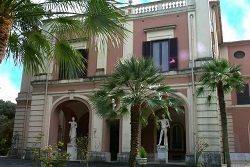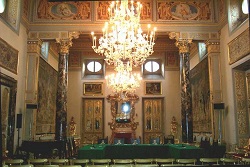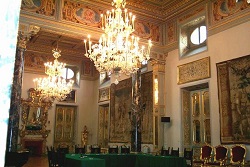Villa Lovatti in Rome
Villa Lovatti in Rome is located in the gardens of Villa Abamelek, formerly the seat of the USSR Embassy in Italy and now owned by the Embassy of the Russian Federation.
Owned by Clemente Lovatti (1777-1859) since around 1815, the building was initially a brick factory, known as the Torre del Drago (Dragon Tower. i. e. the area of the hills on the northern and western edges of the current park of Villa Abamelek, which was known in the 19th century as the "clay hills"). It was transformed by Clemente himself into the "Casina delle Muse" villa around 1850 and took the name Villa Lovatti after the owner's death.
Some hints are in Carla Benocci, Villa Abamelek, Mazzotta, Milan 2001, p. 37, 54 and 103.
Today, Villa
Abamelek is a historic complex of great interest, inheriting a
tradition of refined residences on the outskirts of the city, developed
over three centuries.
The site was originally used for agriculture, favored by the fertile soil,
and for sacred purposes, linked to the network of cemeteries that still
today branch out from the Via Aurelia Antica toward the Porta
Cavalleggeri.
The proximity to the Vatican ensured the area's constant use by merchants
and pilgrims, protected by defensive structures, some traces of which
remain. However, it was between the late 17th and early 18th centuries
that the property became the splendid residence of the Marquis Paolo
Girolamo Torre, a wealthy Genoese banker and patrician, who
commissioned "beautiful and rare paintings," as Pascoli put it,
for his Casino, identifiable with the current Palazzina
Belvedere, visible from the Via Aurelia Antica.
The decorations included both a cycle of frescoes by Giuseppe Passeri,
partly lost, and a series of paintings by Giuseppe Bartolomeo Chiari,
Benedetto Luti, and other artists belonging to the circle of the Accademia
di San Luca, paintings with a classicist influence and
mythological subjects.
The villa thus established itself as a privileged location for rich art
collections: given the quality of the residence and the prestige of the
Marquis Torre, the cardinals gathered in this building on August 22,
1700, ahead of the conclave, during the illness of Pope
Innocent XII Pignatelli, who would die on September 27 of the same
year. Due to financial difficulties, the Torre family was forced to cede
the villa to the Hospital of Santo Spirito in 1722, which in turn
sold it in 1734 to Monsignor Giuseppe Maria Feroni, a Florentine
nobleman, also wealthy and cultured, who would shortly thereafter become a
cardinal. The character of this area outside Porta San Pancrazio
thus consolidated as an area of Florentine influence, secured by the Corsini
family, who had their villa here, and by Cardinal Feroni.
The latter renovated the villa, giving it a new architectural layout,
designed by Alessandro Galilei, and new furnishings, some of a
religious nature and others linked to a taste for "chinoiseries",
with rich Chinese papers on the walls, various objects for games and
entertainment, and original furniture, according to a highly prestigious
fashion also established in other patrician residences in the city.
From the late eighteenth century, the complex entered a period of steady
decline: successively owned by Giovanni Torlonia, Maria Teresa
Marescotti, the Valentini, and the Giraud families, it was severely
damaged during the fighting that marked the end of the Roman Republic in
1849. In 1854, it was purchased by Prince Filippo Andrea V Doria
Pamphilj to annex it to his nearby villa; commissioned by the prince,
the architect Andrea Busiri Vici transformed the garden into a landscape
design, restoring and modifying several buildings. Sold to the Ricasoli
family in 1863, it finally became the property of the Russian prince Semion
Semionovich Abamelek Lazarev.
He restored the villa's former splendor, while also giving it a new image,
designed by architect Vincenzo Moraldi: he purchased the
neighboring vineyards and farmhouses and annexed them to the previous
property, creating a large estate. He developed the 19th-century landscape
garden, using a rich collection of ancient sculptures (an Etruscan
sarcophagus and various Roman statues and busts) and 17th-century
sculptures, placed to decorate the most important viewpoints. He expanded
the 18th-century mansion, known in the 19th century as "Villa
Belvedere" and now known as Palazzina Belvedere, by
building a new building. He transformed the building into a place to serve
the vineyards and the kilns, defining it as a Casino delle Muse or
Theatre, a building that was enriched with a large number of paintings,
especially from the Venetian school, splendid Venetian furnishings,
Flemish tapestries, sculptures from various periods, furniture from
different fields and Roman floor mosaics, constituting a grandiose example
of eclecticism.
The new building was dedicated to the Muses and the Camenae, featuring a
large hall with a stage, intended as a theater, where concerts and
performances were performed, a favorite of both the prince and his wife,
Princess Maria Pavlovna Demidoff. The exterior of the Casino delle
Muse was also designed as a semicircle, in the tradition of
seventeenth-century villa theaters, adorned with large Roman statues. Upon
the prince's death in 1916, the villa became a striking example of great
international patronage, where the classical ideal was revived in a
setting enhanced by diverse art forms.
In the vast 27-hectare park, you can admire numerous scattered buildings, either rebuilt at the behest of Lazaref or left intact. The small theater is noteworthy. An Orthodox church dedicated to Saint Catherine of Alexandria was recently built on the grounds of the villa.


